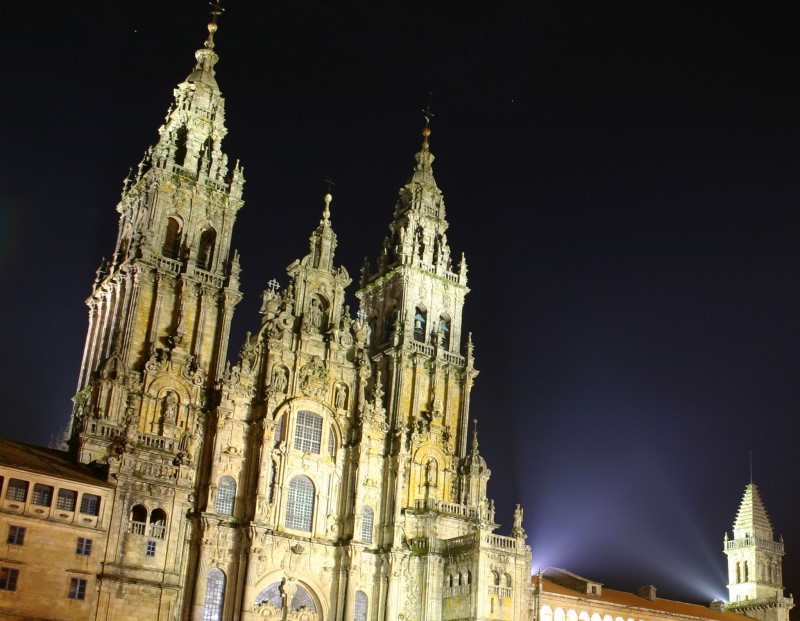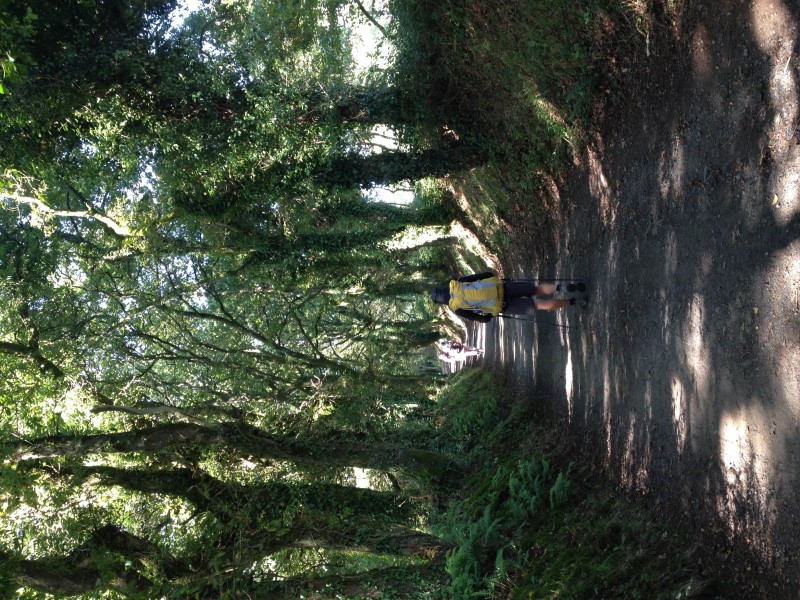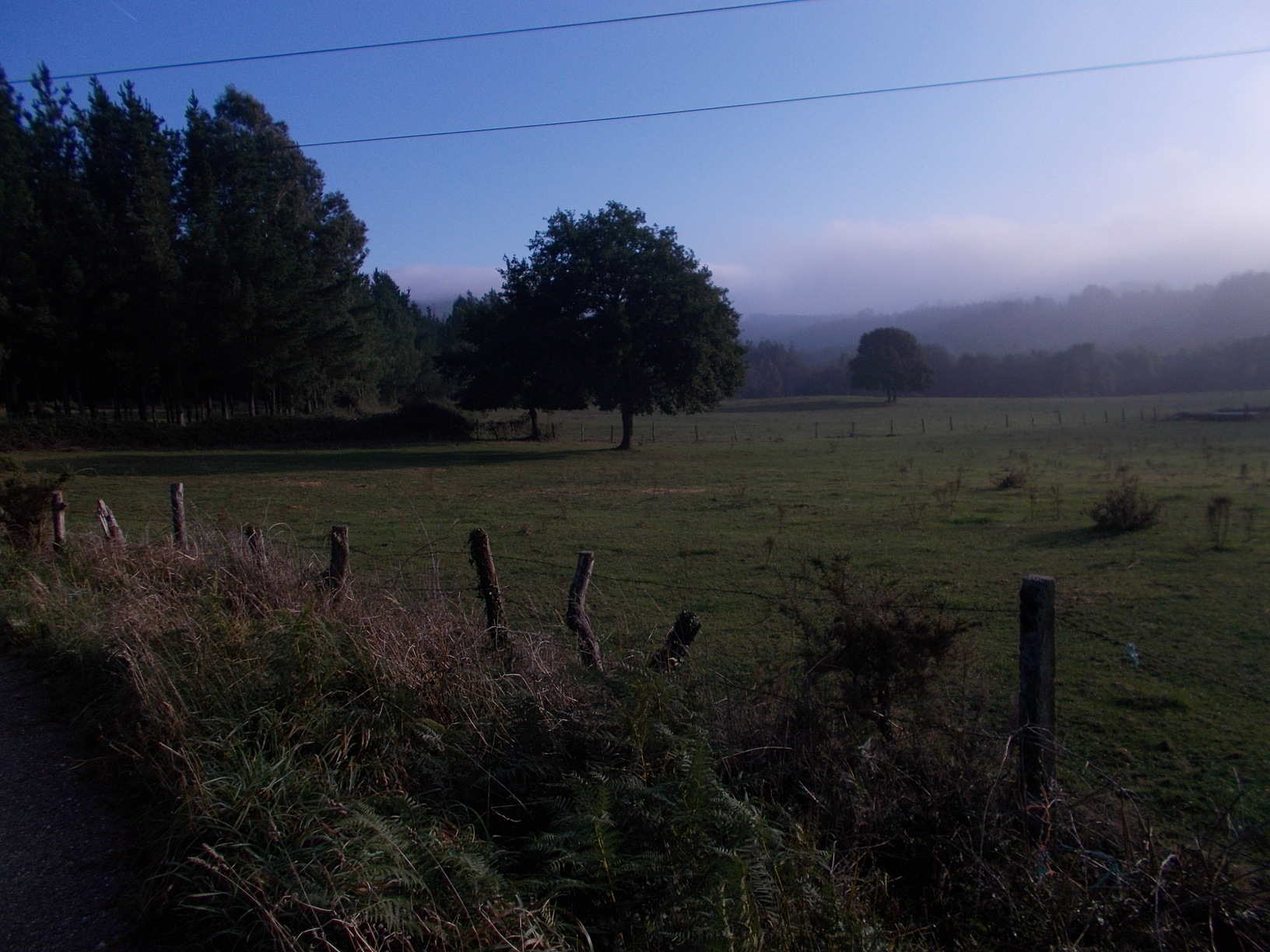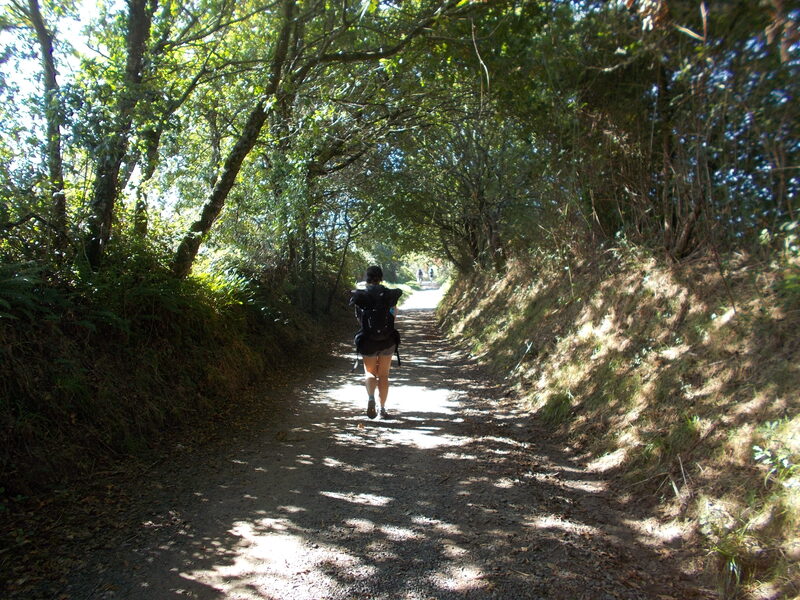
Basic Details
- Starting point: O Pedrouzo, a village of roughly 900 inhabitants, the most typical last stop for pilgrims on their way to Santiago. All services and endless accommodation options for pilgrims.
- Ending point: The cathedral of Santiago de Compostela. Where all routes and destinies meet…
- Availability of alternative routes: No. Obviously once you are in Santiago de Compostela, you can try and follow lesser knows streets to the city center. But in Santiago and close to the pilgrimage routes all roads are busy, and I recommend you to follow the marked route here.
- Distance: 19 km (download GPS here).
- Elevation difference: +395 m, – 420 m.
- Link to online map: here.
- Difficulty score: 2/5
- Beauty score: 3/5 (I’d maybe give 2/5, but due to the emotions and the sheer fact of eventually arriving in Santiago, everything seems a bit more beautiful in the last 10 kilometers).
- Terrain/asphalt: 40%/60%.
- Previous stage: Camino del Norte, Stage no. 30, Boimorto – O Pedrouzo / Camino Frances Stage no. 29, From Arzua to O Pedrouzo.
Elevation profile for the route
 – The last stage is quite hilly and eventful, since you have to climb up the Monte de Gozo, the last hill above Santiago de Compostela, and also the place where some people sleep and drink hard last night, before eventually descending with a hangover to the city the next day, just in time for the midday pilgrim mass in the cathedral.
– The last stage is quite hilly and eventful, since you have to climb up the Monte de Gozo, the last hill above Santiago de Compostela, and also the place where some people sleep and drink hard last night, before eventually descending with a hangover to the city the next day, just in time for the midday pilgrim mass in the cathedral.
Advanced info about the stage
- Trail marking: Spotless, you cannot get lost, especially with the number of pilgrims around. Sure, once you’re already in Santiago, you have to pay attention to the arrows on the roundabouts and other tricky spots, but as long as you pay attention to the arrows and do not rush it, you won’t lose your way.
- Natural places worth seeing: Nothing in particular, but I cannot say this stage is ugly, in any means… The first 10 kilometers you have some nice climbs and descent among eucalyptus trees, and with the typical Galicean fog, it can be quite romantic. Obviously from Monte de Gozo it is all a city walk, but with the emotions high and a good vibe Santiago de Compostela has as a city, it isn’t really a bad stretch either…
- Historical, architectural, artistic, and culinary places worth seeing: Obviously the highlight is Santiago de Compostela. You will find everything in the city–many nice churches, museums, statues, art galleries, clubs with interesting concerts, and so on, and so forth. The few places I’d recommend that aren’t that well known are
- The museum of magic: Extremely well done and an exposition you will remember for a long time. Let your senses get amazed by many demonstrations of the (apparent) breach of laws of physics and nature.
- Parque de la Alameda: The nicest park of Santiago de Compostela, close to the city center and everything else. It is big enough and with enough hidden corners that you can find there a nice peaceful place of reflection after completing your long journey to Santiago.
- Mercado de Abastos: Local produce, fruits, veggies, meats, sweets, fish, flowers, craft work. considered by many as one of the best open markets in the entire Spain, it is open every day except of Sunday. A good place to take a stroll and perhaps collect some authentic souvenirs (not the type of souvenirs made in Chine that you can get in the souvenir shops in the center of the city).
- Camping/bivouac options on this stage: None. Do not camp on the last stage. If you are on extreme budget or have a dog with you or anything, Santiago is the one place to stay inside. Many places around the town accept dogs, just browse the Booking.com to find some. As an example, you can check out this pilgrim hostel.
- Dog friendly score: 2/5. The beginning is great, but things become much worse, with the city walk, the traffic, and everything. However, if you live in a big city back at home, your dog is likely accustomed to such environment, and it won’t trouble it that much. The key is to find a good pilgrim hostel that accepts dogs, ideally with a garden, so your beloved companion gets some well-deserved rest after the long pilgrimage with you…
- Special remarks: Reaching Santiago and completing your pilgrimage is not the same experience for everyone. Some people are happy, others sad, and some feel rather empty, even seeing the entrance to the big city as an anticlimax to their long walk. Whatever emotions you feel, just accept them and let them pass. It is the way that matters, not the destination. And if you happen to love Santiago de Compostela and enjoy your time in town, that’s only better!
Accommodation options on today’s stage
* The infographic displays the number of pilgrim hostels (only pilgrims allowed), hostels (anyone allowed, shared rooms), and other accommodation options (hotels, pensions, etc, private rooms) in each point along the route, together with price range. For exact explanation of the pictograms we use check the explanations page. Below the infographic you will see our recommended picks (up to 3 pilgrim options and 1-2 “privacy” options, maximum five) for the stage, together with important information (but not too much info, just what you need :-)).

Recommended places to sleep along this stage
Pilgrim options:
- Albergue Seminario Menor, Santiago de Compostela (km 19). Location and reviews on Google maps here. Probably the most legendary pilgrim place in Santiago. A building of a former seminary, it offers both shared rooms and small private rooms (with shared bathrooms), for really affordable prices considering we are in Santiago already (starting from 22 euros). The place is perfectly organized, and has everything onsite (shop, restaurant (for breakfast), many machines for clothes washing, vending machines, well-equipped kitchen, etc). Definitely my pick when I stay in Santiago, if they have a free room. Check-in from 1:30 pm. Recommended way of making a reservation: phone call, +34 881 031 768, or booking.com.
- Besides Seminario Menor, there are over 20 other pilgrim albergues in Santiago de Compostela, and some new open (and some may close) each year. I have stayed in a couple of other places, but haven’t like any of them in particular. Anyway, in Santiago virtually all pilgrim places allow booking on Booking.com, so you can just click the link from the paragraph above, and if Seminario Menor doesn’t have any free capacities, you can just browse other pilgrim hostels in the town. If you find one that you like in particular, feel free to write me so we can add it to the list :).
Privacy/luxury options:
- Parador Hotel, Santiago de Compostela (km 19). Location and reviews on Google maps here. If there is one place of true luxury in Santiago–in all senses of the word, it is the famous Parador Hotel, right at the side of the Cathedral. Called also “Hospital Real de Santiago de Compostela”, with prices starting from 250 euro/night, this hotel is a place many pilgrims talk about (often jokingly :)), but few can afford to actually stay there. Well, besides the location, spotless attention to guests and the beauty of the historical building (from both outside and inside), it is also a legendary status which makes this hotel so special, and a no. 1 choice of the millionaires who walk the Camino. Check-in from 3pm, recommended way of making a reservation: booking.com.
- Just like with the pilgrim options, besides the Parador Hotel you have dozens of hotels and other private accommodation options, all around Santiago. The availability is very limited though, especially in high season (which, speaking quite frankly, is a long one in Santiago :), from early June to late September). Hence if you look for a private place below 100 euro/night/room, you’ll have to be quite flexible with the location, and perhaps sleep a couple of kilometers away from the cathedral. Anyway, explore booking for available options for your stay.
Pictures from the stage
 – the cathedral of Santiago at night
– the cathedral of Santiago at night
 – One of the last nice stretches on the Camino
– One of the last nice stretches on the Camino
Few tips at the end
- While there are almost endless accommodation options in Santiago de Compostela, and you will find a bed at any time of the year, budget options are rather limited, as well as the number of beds in places that are frequented mostly (or almost only) by pilgrims. If you are going to reach Santiago anytime between mid May and mid September, I highly recommend you booking your accommodation at least 3 days in advance, ideally even more. In this way you can make sure to get a bed for a decent price, and perhaps even to stay at the same place with friends you made on your pilgrimage :). If nothing decent is available, make sure to check it a few times a day. In a big town like Santiago somebody always cancels their stay last minute or a few days before. Checking Booking.com a few times a day, you can be the one who gets the room that suddenly became available.




![Ultralight Packing List for Camino de Santiago [2025 Edition]](https://caminolovers.com/wp-content/uploads/2022/03/altra-shoes-640-x-480.jpg)


